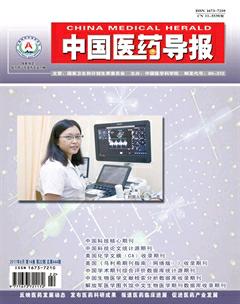沉默酰基辅酶A—胆固醇酰基转移酶1基因对人前列腺癌细胞生物学行为的影响
陈心 徐细明 甘园园
[摘要] 目的 觀察ACAT1在人前列腺癌PC-3细胞增殖和侵袭迁移中的作用。 方法 体外培养人前列腺癌PC-3细胞,通过脂质体HiperFect将ACAT1 siRNA转染至人前列腺癌PC-3细胞中沉默酰基辅酶A-胆固醇酰基转移酶1(ACAT1)基因的表达,Real-time PCR验证沉默的效果。利用CFSE染色法分别检测加入无血清1640培养基的空白对照组、加入阴性-siRNA-HiperFect复合物的阴性对照组和加入ACAT1 siRNA-HiperFect复合物的ACAT1组人前列腺癌PC-3细胞的增殖率,比较ACAT1基因沉默前后细胞增殖的变化。利用Transwell小室法检测ACAT1基因沉默前后人前列腺癌PC-3细胞侵袭和迁移能力的变化。 结果 与空白对照组和阴性对照组比较,ACAT1 siRNA组转染48 h ACAT1 mRNA表达水平最低(P < 0.05)。与阴性对照组和空白对照组比较,ACAT1 siRNA组细胞增殖率下降,侵袭和迁移实验中穿膜细胞数减少,差异有高度统计学意义(P < 0.01)。阴性对照组与空白对照组比较,细胞增殖率、侵袭和迁移能力无变化,差异无统计学意义(P > 0.05)。 结论 ACAT1基因干扰能抑制PC-3细胞的增殖,减弱侵袭迁移能力,为探寻前列腺癌发病机制和治疗提供新的思路和手段。
[关键词] 前列腺癌;酰基辅酶A-胆固醇酰基转移酶1;小干扰RNA;生物学行为
[中图分类号] R734 [文献标识码] A [文章编号] 1673-7210(2017)08(a)-0004-05
[Abstract] Objective To observe the effect of ACAT1 on human prostate cancer cells proliferation, invasion and migration. Methods Human prostate cancer cells (PC-3 cells) were cultured, then the expression of ACAT1 gene in PC-3 cells were interfered using Hiperfect transfection reagent, the expression of ACAT1 gene before and after transfection was detected by Real-time PCR. The proliferation rates of PC-3 cells in the blank control group (serum-free 1640 medium added), the negative control group (negative-siRNA-HiperFect complex added) and the ACAT1 group (ACAT1 siRNA-HiperFect complex added) were analyzed by CFSE staining. The changes of cell proliferation before and after ACAT1 gene silencing were compared. Transwell assays were used to evaluate the effect of ACAT1 gene interfering on cells migration and invasion. Results Compared with the blank control group and the negative control group respectively, ACAT1 mRNA expression level reached the lowest level after 48 hours in the ACAT1 siRNA group (P < 0.05). In the ACAT1 siRNA group, compared with the blank control group and the negative control group, proliferation rate of PC-3 cell decreased, the numbers of invasive cell and migration cell reduced, the differences were statistically significant (P < 0.01). Compared between the blank control group and the negative control group, the differences in proliferation rate, invasion and migration ability of human prostate cancer PC-3 cells had no statistically significant (P > 0.05). Conclusion ACAT1 siRNA reduces proliferation, migration and invasion of PC-3 cells, which maybe provide a new idea and strategy for pathogenesis and treatment of prostate cancer.
[Key words] Prostate cancer; Acyl coenzyme A cholesterol acyltransferase 1; Small interference RNA; Biology behaviorsendprint
前列腺癌是严重威胁男性健康的常见恶性肿瘤之一。在欧美发达国家,前列腺癌的死亡率仅次于肺癌[1]。在我国,虽然前列腺癌的发病率明显低于美国,但是随着国民生活水平的不断提高,我国的前列腺癌发病率也在不断提高[2]。大部分前列腺癌进展缓慢,然而仍有部分患者因发展为侵袭性前列腺癌而死亡。因而,探寻前列腺癌的发病机制和治疗手段对于延长前列腺癌患者的生存时间和提高患者的生活质量都十分重要。流行病学研究发现,亚洲男性移民至欧美国家后,其罹患前列腺癌的概率大大升高,提示前列腺癌的发生与西方的饮食方式密切相关。在西方国家的大规模流行病学研究也证实了,大量动物脂肪的摄入以及胆固醇代谢异常与前列腺癌的发生密切相关[3-5]。体内的动物模型进一步发现高脂饮食引起的高胆固醇血症能促进前列腺癌的转移[6]。
酰基辅酶A-胆固醇酰基转移酶(acyl coenzyme A-cholesterol acyltransferase,ACAT)是细胞内质网上一种催化游离胆固醇与长链脂肪酸连接形成胆固醇酯的酶。ACAT有两种形式同工酶:ACAT1和ACAT2。ACAT1在人体内广泛分布,内皮细胞、巨噬细胞、肾脏、淋巴结以及前列腺上均有分布,而ACAT2则主要分布于小肠细胞和肝细胞上。有研究发现,前列腺癌组织较正常组织ACAT1表达明显升高[7]。本研究通过RNA干扰技术观察ACAT1基因干扰对人前列腺癌细胞增殖、侵袭迁移能力的影响,阐明ACAT1在前列腺癌的发病机制中的作用,寻求可能的治疗靶点。
1 材料与方法
1.1 主要试剂
胎牛血清(美国Sigma公司),1640培養基(美国Gibco公司),ACAT1 siRNA和RNA提取试剂盒(美国Qiagen公司), M-MLV cDNA合成试剂盒和荧光定量PCR试剂盒(美国Invitrogen公司),CFSE细胞增殖试剂盒(赛默飞世尔科技公司),transwell小室(美国Corning公司),Matrigel胶(美国BD公司)。
1.2 细胞培养
人前列腺癌细胞株PC-3购自武汉大学生命科学研究院细胞库,细胞贴壁生长于含10%胎牛血清的1640培养基中,置于37℃、5% CO2、95%湿度培养箱中传代培养。
1.3 细胞转染
PC-3细胞按5×105/孔接种于6孔培养板,加入siRNA-HiperFect复合物。实验分为三组,空白对照组加入无血清1640培养基;阴性对照组加入阴性-siRNA-HiperFect复合物;ACAT1组加入ACAT1 siRNA-HiperFect复合物。细胞转染后于培养箱内孵育24、48、72 h后分别收集转染细胞进行后续实验,实验重复3次。
1.4 实时定量PCR
采用RNA提取试剂盒抽提细胞总RNA,cDNA的制备使用M-MLV cDNA合成试剂盒进行逆转录反应。SYBR Green Ⅰ荧光染料法进行实时荧光PCR。采用管家基因β-actin作为内参,引物由美国Invitrogen公司合成,引物序列见表1。ACAT1反应条件:预变性94℃,10 min;94℃,30 s,55℃,1 min,72℃,2 min,共35个循环;最后72℃,延伸10 min。用β-actin作内参照,反应条件:预变性95℃,10 min;95℃,30 s,57℃,1 min,72℃,2 min,共35循环;最后72℃,延伸10 min。在延伸的过程中搜集荧光信号,于每次扩增的同时设置无cDNA的阴性对照。扩增结果采用FTC2000荧光PCR仪自带的实时荧光定量PCR分析程序对结果Ct值进行分析,然后计算得出基因表达的倍数改变2-ΔΔCt,即ΔΔCt 阴性对照组=(CtACAT1- Ctβ-actin)阴性对照组-(CtACAT1- Ctβ-actin)空白对照组;ΔΔCt ACAT1组=(CtACAT1- Ctβ-actin) ACAT1组-(CtACAT1- Ctβ-actin)空白对照组。
1.5 CFSE标记法检测细胞的增殖能力
收集对数生长期的PC-3细胞,调整细胞浓度为5×106个/mL,加入CFSE至终浓度为5 μmol/L,置37℃培养箱,温育10 min;然后加入等体积胎牛血清中和,离心;加入PBS洗涤2次,收集细胞,培养72 h后,利用流式细胞仪检测细胞增殖状况,FlowJo V10进行分析。实验重复3次。
1.6 Transwell体外实验检测细胞侵袭能力
将Matrigel胶与无血清培养即按1∶3均匀地铺在8 μm PCF细胞小室膜上,放入37℃培养箱中,孵育4~5 h使其凝结成胶状。各组细胞用无血清1640培养基洗3次,调节细胞浓度至 5×105个/mL,transwell上层小室中加入200 μL细胞悬液(1×105个/孔)。24孔板的小室下层中加入500 μL含20%FBS的细胞上清。37℃培养箱中,孵育48 h。取出transwell小室,小心擦去小室底层膜和未穿膜的细胞,PBS冲洗小室膜3次,甲醛固定30 min,取出控干,加入结晶紫染色。在倒置显微镜(400×)下计数上、下、左、右和中间5个视野的肿瘤细胞数,每组实验重复3次。
1.7 Transwell体外实验检测细胞迁移能力
方法同“1.6”项下侵袭实验,不同在于上室中不铺Matrigel基底膜。各组细胞用无血清1640培养基洗3次,调节细胞浓度至5×105个/mL,transwell上层小室中加入200 μL细胞悬液(1×105 个/孔)。24孔板的小室下层中加入500 μL含20%FBS的细胞上清。37℃培养箱中,孵育48 h。取出transwell小室,小心擦去小室底层膜和未穿膜的细胞,PBS冲洗小室膜3次,甲醛固定30 min,取出控干,加入结晶紫染色。在倒置显微镜(400×)下计数上、下、左、右和中间5个视野的肿瘤细胞数,每组实验重复3次。endprint
1.8 统计学方法
采用GraphPad Prism 6.0统计学软件进行数据分析,计量资料数据用均数±标准差(x±s)表示,多组间比较采用单因素方差分析,组间两两比较采用LSD-t检验,以P < 0.05为差异有统计学意义。
2 结果
2.1 实时定量PCR检测PC-3细胞转染siRNA后ACAT1 mRNA的表达
ACAT1 siRNA组PC-3细胞ACAT1 mRNA表达较空白对照组和阴性对照组明显下降,24、48、72 h ACAT1 mRNA的表达分别为空白组的0.78、0.45、0.56倍,差异有高度统计学意义(P < 0.01),而空白对照组与阴性对照组ACAT1 mRNA表达比较差异无统计学意义(P > 0.05)。ACAT1 siRNA组中48 h与24 h转染比较,ACAT1 mRNA表达差异有统计学意义(P < 0.05),但是72 h与48 h比较差异无统计学意义(P > 0.05)。因此,在后续实验中,采用48 h转染。见表2。
2.2 ACAT1 siRNA对PC-3细胞增殖的影响
结果发现,转染ACAT1 siRNA后,PC-3细胞增殖率为(12.4±1.6)%,与空白对照组[(23.3%±2.1)%]和阴性对照组[(19.4%±1.6)%]比较下降,差异有高度统计学意义(P < 0.01);空白对照组与阴性对照组比较,细胞增殖率差异无统计学意义(P > 0.05),说明利用ACAT1 siRNA转染沉默ACAT1基因的表达能抑制PC-3细胞的增殖。
2.3 ACAT1 siRNA对PC-3细胞侵袭和迁移的影响
如图1、2所示,ACAT1 siRNA转染PC-3细胞后,与空白对照组和阴性对照组比较,PC-3细胞侵袭和迁移的细胞数量减少,差异有高度统计学意义(P < 0.01);空白对照组与阴性对照组比较,差异无统计学意义(P > 0.05);说明抑制ACAT1基因的表达会降低PC-3细胞侵袭和迁移的能力。
3 讨论
胆固醇是人体不可或缺的重要物质,它不仅是细胞膜的重要组成成分,而且是合成维生素、甾体激素和胆汁酸的原料。研究发现,胆固醇代谢的异常会导致细胞生长或凋亡基因变化,从而刺激肿瘤发生发展[8]。关于胆固醇和前列腺癌关系的流行病学研究发现,胆固醇水平较低的患者进展为高分级前列腺癌的风险较低,而体内胆固醇含量高的患者更易罹患前列腺癌[9-10]。高胆固醇血症是患高侵袭性前列腺癌的危险因素[11]。胆固醇的含量不仅与前列腺癌的发生发展密切相关,研究还发现前列腺癌导致的死亡率与胆固醇含量也同样相关[12]。利用他汀类的降脂药可以降低高级别高侵袭性前列腺癌的风险[13]。
研究发现,在进展为激素抵抗性前列腺癌的过程中,胆固醇代谢发生了一系列的变化,作为雄激素合成原料的游离胆固醇增多,促使胆固醇入胞的酶和胆固醇合成的酶也都发生了改变[14]。人体内胆固醇的来源有两种,依赖于从外源性食物中摄取的外源性胆固醇和依赖于体内合成方式产生的内源性胆固醇。内源性胆固醇始于一系列酶介导的乙酰辅酶A的酶促反应,游离的胆固醇经由ACAT催化形成胆固醇酯储存在细胞内,大量的胆固醇酯蓄积在前列腺癌中既可以作为雄激素的原料储备,又可以减少过高的游离胆固醇对细胞的毒性[14]。因而,前列腺癌的进展可能与雄激素合成的上游和旁路信号途径密切相关[15],包括胆固醇的代谢、脂肪酸的合成和胆固醇酯的堆积。
近年来,研究发现,ACAT作为胆固醇代谢过程中的关键酶,与胆固醇代谢相关疾病密切相关,其不仅与阿尔兹海默病、冠状动脉硬化的发病相关,还与肿瘤的发生和发展相关[16-17]。在人急性淋巴白血病细胞的增殖过程中膽固醇酯必不可少,而ACAT抑制剂会明显抑制人急性淋巴白血病细胞的增殖[18]。在脑胶质瘤、乳腺癌、结直肠癌、肾透明细胞癌和胰腺癌等一系列的恶性肿瘤中均发现ACAT活性增加,而ACAT1抑制剂能显著降低恶性肿瘤细胞增殖和侵袭[19-20]。然而ACAT1在前列腺癌发病机制中的作用国内外较少研究。
本课题以人前列腺癌PC-3细胞为研究对象,利用ACAT1 siRNA抑制前列腺癌细胞中ACAT1基因的表达,结果发现,ACAT1 siRNA干扰ACAT1基因表达后会,导致PC-3细胞增殖能力下降,侵袭和转移能力降低,考虑ACAT1在前列腺癌的发生发展中起重要作用,为未来治疗前列腺癌提供了新的思路。前列腺癌作为发病率、死亡率迅猛上升的常见恶性肿瘤,不仅给患者带来了巨大痛苦,也给其家庭和社会带来了沉重的经济负担。未来将进一步深入研究胆固醇酯合成、花生四烯酸以及游离胆固醇水平在前列腺癌发生发展中的作用,以期通过靶向胆固醇的代谢,为前列腺癌寻找到新的治疗靶点。
[参考文献]
[1] Siegel RL,Miller KD,Jemal A. Cancer statistics,2015 [J]. CA Cancer J Clin,2015,65(1):5-29.
[2] 刘芳,王依洁,单雄威,等.2型糖尿病对前列腺癌发病风险和预后的影响[J].临床泌尿外科杂志,2016,31(10):946-949.
[3] Pelton K,Freeman MR,Solomon KR. Cholesterol and prostate cancer [J]. Curr Opin Pharmacol,2012,12(6):751-759.
[4] Krycer JR,Brown AJ. Cholesterol accumulation in prostate cancer: a classic observation from a modern perspective [J]. Biochim Biophys Acta,2013,1835(2):219-229.endprint
[5] Bhindi B,Locke J,Alibhai SM,et al. Dissecting the association between metabolic syndrome and prostate cancer risk: analysis of a large clinical cohort [J]. Eur Urol,2015, 67(1):64-70.
[6] Moon H,Ruelcke JE,Choi E,et al. Diet-induced hypercholesterolemia promotes androgen-independent prostate cancer metastasis via IQGAP1 and caveolin-1 [J]. Oncotarget,2015,6(10):7438-7453.
[7] Saraon P,Cretu D,Musrap N,et al. Quantitative proteomics reveals that enzymes of the ketogenic pathway are associated with prostate cancer progression [J]. Mol Cell Proteomics,2013,12(6):1589-1601.
[8] Ribas V,Garcia-Ruiz C,Fernandez-Checa JC. Mitochondria,cholesterol and cancer cell metabolism [J]. Clin Transl Med,2016,5(1):22.
[9] Platz EA,Till C,Goodman PJ,et al. Men with low serum cholesterol have a lower risk of high-grade prostate cancer in the placebo arm of the prostate cancer prevention trial [J]. Cancer Epidemiol Biomarkers Prev,2009,18(11):2807-2813.
[10] Morote J,Celma A,Planas J,et al. Role of serum cholesterol and statin use in the risk of prostate cancer detection and tumor aggressiveness [J]. Int J Mol Sci,2014,15(8):13615-13623.
[11] Schnoeller TJ,Jentzmik F,Schrader AJ,et al. Influence of serum cholesterol level and statin treatment on prostate cancer aggressiveness [J]. Oncotarget,2017. [Epub ahead of print].
[12] Batty GD,Kivimaki M,Clarke R,et al. Modifiable risk factors for prostate cancer mortality in London: forty years of follow-up in the Whitehall study [J]. Cancer Causes Control,2011,22(2):311-318.
[13] Bansal D,Undela K,D'cruz S,et al. Statin use and risk of prostate cancer: a meta-analysis of observational studies [J]. PLoS One,2012,7(10):e46691.
[14] Ghosh S. Early steps in reverse cholesterol transport: cholesteryl ester hydrolase and other hydrolases [J]. Curr Opin Endocrinol Diabetes Obes,2012,19(2):136-141.
[15] Antognelli C,Ferri I,Bellezza G,et al. Glyoxalase 2 drives tumorigenesis in human prostate cells in a mechanism involving androgen receptor and p53-p21 axis [J]. Mol Carcinog,2017. [Epub ahead of print]. DOI:10.1002/ mc.22668.
[16] Garcia-Bermudez J,Birsoy K. Drugging ACAT1 for Cancer Therapy [J]. Mol Cell,2016,64(5):856-857.
[17] Yang W,Bai Y,Xiong Y,et al. Potentiating the antitumour response of CD8(+)T cells by modulating cholesterol metabolism [J]. Nature,2016,531(7596):651-655.
[18] Uda S,Accossu S,Spolitu S,et al. A lipoprotein source of cholesteryl esters is essential for proliferation of CEM-CCRF lymphoblastic cell line [J]. Tumour Biol,2012,33(2):443-453.
[19] Li J,Lee SY,Gu D,et al. Abstract B50:Abrogating cholesterol esterification suppresses pancreatic cancer growth and metastasis mediated by caveolin-1 [J]. Cancer Res,2015,75(13 Supplement):B50.
[20] Ye K,Wu Y,Sun Y,et al. TLR4 siRNA inhibits proliferation and invasion in colorectal cancer cells by downregulating ACAT1 expression [J]. Life Sci,2016,155(2016): 133-139.
(收稿日期:2017-04-21 本文編辑:程 铭)endprint

